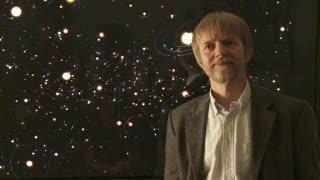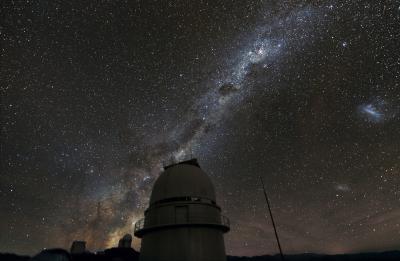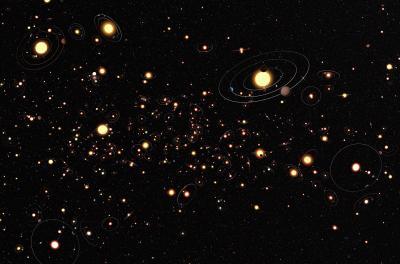Uffe Gråe Jørgensen explains that you need to have two stars that lie on a straight line in relation to us here on Earth. Then the light from the background star is amplified by the gravity of the foreground star, which thus acts as a magnifying glass. When the stars pass close by each other in the sky, astronomers can observe the light from the background star first increase and then decrease again. If there is a planet around the foreground star, there might be a little extra bump on the light curve. But if the planet is very close to the star, the bump 'drowns' on the light curve, and if the planet is very far from star, you do not see it. "Therefore the method is most sensitive to planets that lie at an Earth-like distance from a star," explains Uffe Gråe Jørgensen.
It is rare that two planets pass by each other closely enough to create a microlens. We have therefore implemented a strategic search on two levels. Every starry night the research group scans 100 million stars using telescopes in Chile and New Zealand. If the scanning identifies a stellar location with a possible microlensing effect, it is automatically registered and all researchers are notified. Then the best 'lenses' are observed more closely at high resolution and their light curves are analysed. One of the places this is done is at the Danish 1.5 meter telescope at ESO's La Silla Observatory in Chile.
"In a six year period from 2002 to 2007, we observed 500 stars at high resolution. In 10 of the stars we directly see the lens effect of a planet, and for the others we could use statistical arguments to determine how many planets the stars had on average. To be exact, we found that the zone that corresponds to the area between Venus and Saturn in our solar system had and average of 1.6 planets the size of five Earth masses or more," explains Uffe Gråe Jørgensen.

Uffe Graae Jorgensen is an astrophysicist, associate professor, and head of the research group Astrophysics and Planetary Science at the Niels Bohr Institute, University of Copenhagen.Uffe Graae Jorgensen explains the new results about exoplanets. Planets orbiting around stars are more the rule than the exception and many of the planets are surprisingly similar to our own Earth. We now know that are as many as 10 billion such planets in the Milky Way. Uffe Gråe Jørgensen also explains about the method they have used called gravitational microlensing observations and he explains what a standard solar system looks like.
(Photo Credit: Niels Bohr Institute)
Billions of habitable planets
The microlensing results complement the best existing transit and radial velocity measurements. Using transit measurements, the American Kepler satellite has identified a very large number of relatively small planets in orbits smaller than even the innermost planet in our own solar system, Mercury, while many years of radial velocity measurements have revealed a large number of very large planets in both very small orbits and slightly larger orbits.
"Our microlensing data complements the other two methods by identifying small and large planets in the area midway between the transit and radial velocity measurements. Together, the three methods are, for the first time, able to say something about how common our own solar system is, as well as how many stars appear to have Earth-size planets in the orbital area where liquid what could, in principle, exist as lakes, rivers and oceans – that is to say, where life as we know it from Earth could exist in principle," says Uffe Gråe Jørgensen.
He explains that a statistical analysis of all three methods combined shows that out of the Milky Way's 100 billion stars, there are about 10 billion stars with planets in the habitable zone. This means that there may be billions of habitable planets in the Milky Way. For thousands of years people have been guessing how many planets there might be out there among the stars, where we could, in principle at least, live. Today we know this.
Are we alone in the universe?
But it is one thing, that the planets have the right temperature to be habitable in principle, but quite another thing, whether they are inhabited – whether there is life and perhaps even intelligent life on the planets.
"There are so many unique events in our solar system that have created the basis for the development of life on Earth. Comets brought water to our planet so that life could arise and a series of random events set in motion an evolution that lead to humans and intelligent life. It is very unlikely that the same circumstances would be present in other solar systems," believes Uffe Gråe Jørgensen, "but perhaps other coincidences in other solar systems have led to entirely different and exciting new forms of life. Recent research of planets around other stars has shown us that there is in any case billions of planets with orbits like Earth and of comparable size to the Earth."

Every starry night 100 million stars are observed using telescopes in Chile and New Zealand. If the search identifies a stellar location with a possible microlensing effect, it is automatically registered. Then the best "lenses" are observed more closely at high resolution and their light curves are analyzed. One of the places this is done is at the Danish 1.5 meter telescope at ESO's La Silla Observatory in Chile.
(Photo Credit: ESO/Z. Bardon)

There are 100 billion stars in the Milky Way. Observations show that planets orbiting around stars are more the rule than the exception and approximately one out of every ten stars have a planet roughly the size of the Earth with an orbit that, if there was water and atmosphere, would create a temperature and climate roughly that same as on Earth -- we could live there.
(Photo Credit: ESO/M. Kornmesser)
Source: University of Copenhagen